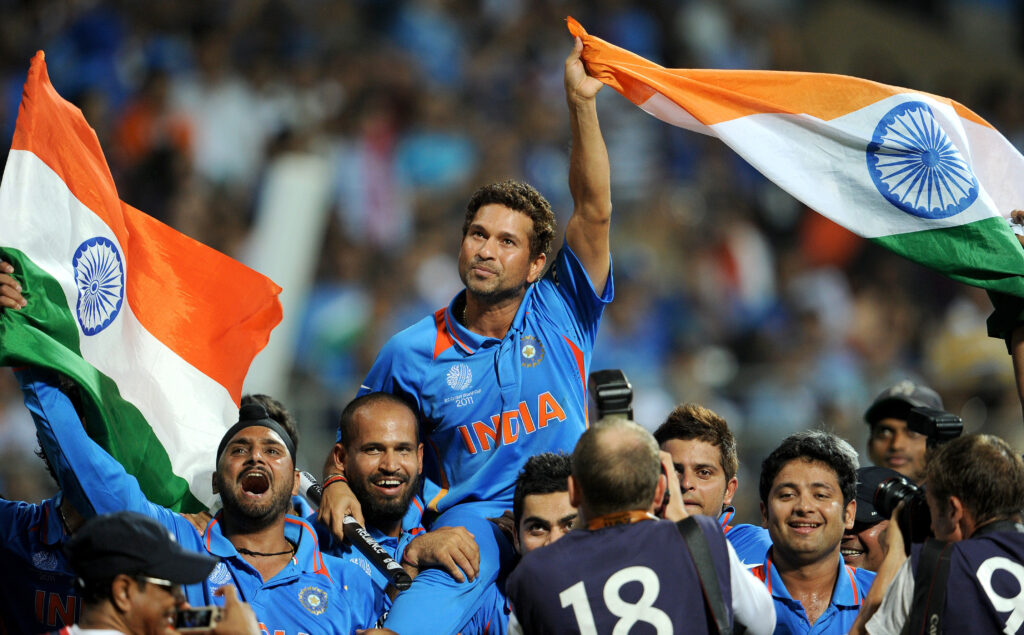
It was Mumbai, and it was India-Sri Lanka in a World Cup final. A match that will forever have a special place in the history of Indian cricket.
A look back.
April 2, 2011 had just turned to April 3. However, it was midnight like no other. Most of India had bid sleep a temporary farewell. It was party time. It was a haphazardly progressing passage of temporal sequences, where every bylane in every Indian city, irrespective of its geographical location, was engulfed in unimagined euphoria, commemorating the actualisation of world dominance. Delhi, Mumbai, Kolkata and Bengaluru were partying. Guwahati was partying, and so was Bhubaneshwar. After a prolonged twenty-eight years of agony, the World Cup had been won. Sri Lanka, despite a Mahela Jayawardene classic, had been beaten. Lasith Malinga, despite an early threat, had been neutralised and the agony of the 2007 World Cup avenged.
It was past midnight when the players made it back up to the sixth floor of the Taj Mahal Hotel in Mumbai. A journey that normally takes twenty minutes, had taken close to three hours. However, it hardly mattered. No one seemed to be in a hurry, and every player was trying to soak in as much of what was going on as possible. Videos were being made and photographs taken almost every second. The moment had to be frozen for posterity. Eleven Gods had given a billion Indians a night to remember and, subsequently, turned immortal.
The Taj Mahal Hotel, a centre of public attention some two-and-a-half years earlier for very different reasons, was back in all its glories—all lit up and a symbol of a resurgent India, scarred yet potent enough to come back stronger and far more appealing. It was in many ways very similar to the Indian cricket team. There were as many television cameras focused on it as there were on that fateful night of November 26, 2008, when highly trained assailants attacked the Taj in one of the deadliest terrorist attacks in India’s history. Only, this time, no one feared for their lives and no commandoes had to be readied. It was a battle won, but with weapons of a different kind, by an army possessing a different avatar—a troop of spirited achievers, wielding willow and chasing leather, helmed by MS Dhoni. And yes, Pakistan had been beaten in the process.
Gautam Gambhir, who is an ardent admirer of the armed forces—he wanted to be part of the artillery arm of the Indian army before his cricketing dream took flight—had made the jawans proud with his valiant 97 and, for once, didn’t object to being called a hero. The Taj Mahal Hotel, full of fans from the world over was once again a cosmopolitan melting pot, pulsating with life and all set for another sleepless night, albeit a very different one.
To go to Mahela Jayawardene, the hero for Sri Lanka. “The moment we stepped inside the ground, we sensed something different,” said Mahela. “For as long as you were there, the crowd kept chanting ‘Sachin, Sachin’. I have never experienced something like this ever in my career. Yes we lost the final but the memories will remain forever.”
It was all one big party, indeed. Beating Australia, Pakistan and Sri Lanka in one week, Indian cricket had never had it better. Australia were the defending champions, Pakistan the arch-enemy and Sri Lanka the opposition that had knocked India out of the 2007 edition of the tournament in the Caribbean. Each was a special victory and a story in itself. Knockout games always have an additional degree of significance, and this was the biggest stage of them all.
A confession is in order here. When I was co-writing Playing It My Way, one of the things I was very keen on knowing was what emotion Sachin Tendulkar felt when Dhoni hit the winning six at the Wankhede. From the time the ball had left his bat to it sailing over the ropes, less than three or four seconds, at best, had elapsed. What was Sachin thinking as he tracked the ball from the twenty-two-yard strip to over the boundary? To my disappointment, he had not watched Dhoni hit the winning runs.
“I was in the dressing room with Virender Sehwag and had even forbidden Viru from going out to the balcony,” admitted Tendulkar. “I have seen the shot a million times on television thereafter but no, I did not see Dhoni hitting it.”
And that was when I told him that I had not either. I had already taken my position outside the Wankhede for the live post-match broadcast and had missed the last few balls of the Indian innings. Not me alone, but every television journalist covering the World Cup had missed that magical moment. You had to go on air the moment the match was over, and Dhoni’s six meant our work had just begun. But what missing out on seeing Dhoni dispatch it into the stands in real time did was give me a glimpse of people on the road as the celebrations gradually got underway. It is a cliché to say that adults behaved like children, but if you really wanted to see thousands do just that, the night of April 2, 2011 would be a stand-out case study.
As India take on Sri Lanka again at the very same ground, every one of us who watched that match on April 2, 2011 will go back in time and reminisce. Memories, as they say, are forever.



